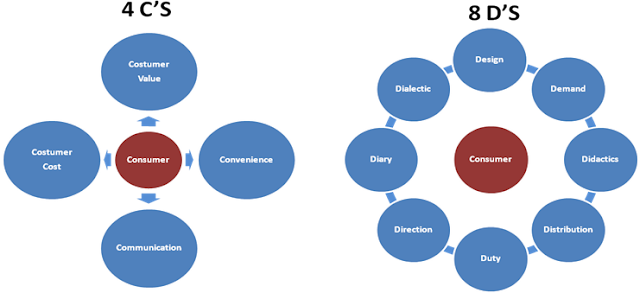Since the beginning of 2000, a series of theories have been developed to explain the changes that have occurred in marketing strategies.
In the early years, marketing strategies were defined as processes aimed at planning and executing products (and also goods, ideas, services) to reach a final consumer, so that the process would be beneficial for the organization, that is, processes with he consumer as end.
In this first paradigm the theory of the 4 P'S which allowed us, in a didactic and synthetic way, to define a set of ideal characteristics of our product so that it would be suitable for the consumer. It was a marketing strategy aimed at optimising business resources to offer our best product (product in the extensive sense, well manufactured or not, with a pricing, distribution, communication policy...) to the client or consumer.
Linear, direct, effective, from “inside out”.
In recent years, especially thanks to the work of Lauterborn and Hayman among others, a series of marketing theories and strategies have been established that define a new paradigm that is being successfully applied by the main companies and institutions in the world and which consists of defining marketing strategies. “outside in”, That is to say, of the consumer to the company.
A time when We don't sell products, we satisfy needsWe do not sell mattresses, we satisfy the need to sleep in the most comfortable, ergonomic, cheap, clean and elegant way possible..
In this situation Lauterborn and Hayman theorize a series of paradigms that attempt to explain marketing relationships from the perspective of the consumer himself, from the need to satisfy his needs.
Both theories focus on a In-depth customer analysis (motivations, habits, needs, etc.) that ultimately allows us to define a business strategy that helps us meet these needs with products (services, goods, etc.), at appropriate prices, marketed effectively, with attractive designs, advertised and distributed correctly, that generate value and brand for the company.
Complex products and services for complex consumers, or rather, if you prefer, specific products for specific consumers. In the fullest sense of the word specific. In this process of satisfying needs, we see how large companies adapt and stop marketing products in a traditional way.
We can all agree that Apple does not sell technological products, it sells expertise, design, innovation, status and exclusivity. Or not?
What will be the next step? I think we are beginning to see it. It is no longer enough to know the consumer in depth and to generate products and services that meet their needs.
We need to try to implement a more holistic vision in business logic that places the consumer in their correct place within the marketing strategy.
Today, society is changing faster than ever, and observing, identifying and defining these changes is therefore more difficult than it was before. Thanks to the revolution represented by new technological advances and new forms of social relationships (social networks, for example), consumers have a direct relationship with our brands, which means that we have to be constantly alert and constantly interact with them.
Therefore, in addition to traditional marketing strategies, we must begin to introduce into our way of acting strategies for controlling and measuring behaviors, situations, present attitudes When the customer already has/enjoys our product or service or before receiving it, in the way of receiving it. Strategies that, ultimately, measure, control and plan based not only on an exhaustive study of the consumer but, above all, on the relationship between the consumer and the brand.
In this situation we can focus attention on the relationship between the consumer and 3 variables:
Process: It is crucial to control and coordinate, in a global way, the processes required for the development, promotion and delivery of a certain good. Understanding that the processes of manufacturing, distribution, marketing, design, etc. that involve a product have to be planned and interrelated in an efficient and effective manner and this results in obtaining quality products.
Physical evidence or Environment: We must take into account, more than ever, the relationship between the environment and the consumer (not necessarily the physical environment, in an online service or business the environment can be the design or accessibility of the site, etc.). The environment, with which we wrap the product, must be effective and efficient depending on the characteristics of our product, the idea or brand image we want to convey and the needs that the client has in relation to the space.
People: It is more than important to select the right staff, with the necessary knowledge and qualities to guarantee, on the one hand, proper customer service and, on the other hand, to be able to transmit the ideology, vision and objective of the company.
The consumer is no longer the end in our marketing strategy (old paradigm 4 P's), nor is he essentially a means (current paradigm 4 C's, 8 D's, among others). The consumer is the essential piece that, in a holistic and global model, It starts the process, serves to measure the functioning of the process started (it defines the effectiveness of the process) and ends up adding value to the brand..
From the needs that a consumer has we generate brands, products, we give them a set of characteristics such as shape, price, design, distribution, but it is the consumer, through their experience with our brand, which gives them value, image, satisfaction, demands attention and relationship, innovation, and it is from this direct and continuous relationship with the client that we build and re-build our brand.
And the greater the relationship we manage to generate with consumers and the better we cover these new variables, the stronger our starting point will be as a brand to start again the process of defining needs, creating products, offering them, communicating them, measuring their impact... and starting the process all over again.
A continuous and perpetual direct consumer/brand relationship process.
Paco Escudero Muniz



